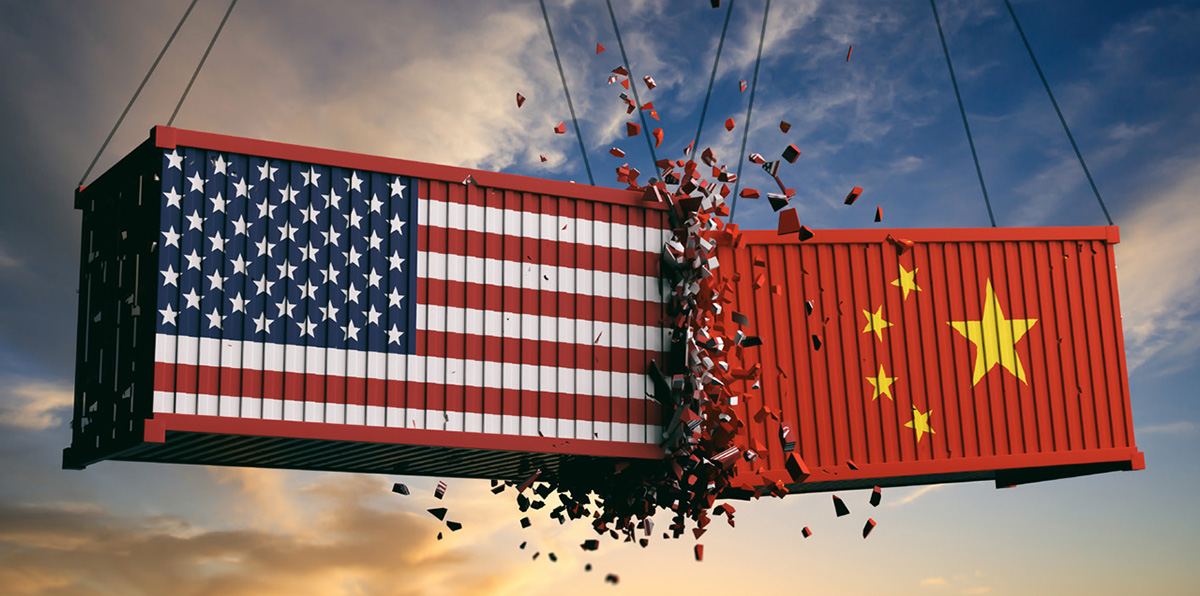U.S.-China Trade: If We Get to Yes, Will It Make Any Difference?
A trade agreement with China will be good news in the short term, but the path to lasting improvement in the relationship, as well as political success for President Trump, is a narrow one.
BY WILLIAM A. REINSCH
The rapid rise of China to the status of economic powerhouse has roiled marketplaces all over the world and caused serious disruptions in the global trading system. Part of this was inevitable—in economics, as in many things, size matters, and China is the proverbial 800-pound gorilla. Once it emerged from its largely self-imposed economic cocoon, it was bound to leave a very large footprint.
But that footprint has proved heavier than expected, in large part because of the policies China has chosen to pursue. Having watched the rapid development of Japan, the original “capitalist developmental state” (a term coined by Chalmers Johnson), and then the Asian Tigers—South Korea, Hong Kong, Singapore and Taiwan—China has developed its own blend of state control and market policies, with the emphasis on the former.
It did not start out that way, however. When China sought to join the World Trade Organization, its premier at the time, Zhu Rongzhi, made clear that his government saw WTO accession and the obligations it required as a means of bringing China into the Western trading system and forcing internal reforms. That was then. Now, the current Chinese leader, Xi Jinping, strongly favors state-owned enterprises over private companies and uses a mix of tactics that are creating consternation in developed economies, beginning with the United States. These changes, and the negative consequences they have for China’s own economy, are well documented in the latest book by Nick Lardy of the Peterson Institute, The State Strikes Back (2019).
The past several U.S. administrations have all complained about Chinese theft of American intellectual property, unfair and discriminatory treatment of U.S. companies operating in China, forced technology transfer, channeling of resources to state-owned enterprises and massive subsidies. But they soft-pedaled such criticism to obtain cooperation on other foreign policy goals, such as Iran, North Korea and climate change. In contrast, the Trump administration decided to tackle these practices head on.
In the summer of 2017, U.S. Trade Representative Robert Lighthizer began an investigation of Chinese policies and practices under Section 301 of the Trade Act of 1974. That section authorizes retaliation against “acts, policies or practices that are unreasonable or discriminatory and that restrict or burden U.S. commerce” (emphasis added).
The Cost of Doing Business with China
On March 22, 2018, USTR released its report, “Findings of the Investigation into China’s Acts, Policies and Practices Related to Technology Transfer, Intellectual Property and Innovation under Section 301 of the Trade Act of 1974.” The report focused on four practices:
I. Unfair Technology Transfer Regime for U.S. Companies in China. The Chinese government uses formal and informal joint venture requirements to prohibit U.S. companies from operating in certain industries without a Chinese partner, often requiring the Chinese partner to be the majority shareholder. The government uses licensing processes to force U.S. companies to transfer technologies to their Chinese joint venture partner. Provisions in licensing and review processes are vaguely worded, giving Chinese authorities wide discretion on which rules to apply. Foreign companies either comply or risk being shut out of the Chinese market.
II. Discriminatory Licensing Restrictions. China’s technology regulatory regime forces U.S. companies to conduct technology transfer on non–market–based terms, and prohibits them from negotiating their own terms with Chinese partners. China applies different rules for technology transfer between domestic firms than between a Chinese and a foreign firm. Regulations for the latter are burdensome and discriminatory, mandating that licensees can use the technology in perpetuity even after licensing contracts expire.
III. Outbound Investment and Subsidies. The Chinese government encourages outbound foreign direct investment, particularly in the tech sector, to advance its military and economic strategic goals. Chinese companies have established presences in Silicon Valley with the objective of acquiring technologies. Investments are often driven by state-owned enterprises or financed by government-backed banks, which gives Chinese companies an unfair competitive advantage when investing in technology, because they are not constrained by risks. In addition, Chinese government subsidies artificially inflate acquisition costs, which allows Chinese companies to expand global market share at the expense of U.S. companies.
IV. Unauthorized Intrusions into U.S. Commercial Computer Networks and Cyber-Enabled Theft of Intellectual Property and Sensitive Commercial Information. China has used cyber intrusions into U.S. commercial networks to gain access to “trade secrets, technical data, negotiating positions and sensitive, proprietary, internal communications.” Cyber intrusions target a wide range of industries, but are most pervasive in high-tech sectors.
While some elements of Chinese policy are similar to those Japan employed in the 1980s, there are some important differences. Ironically, one is that China is more open to imports than Japan was.
The report identified several other issues including “Chinese measures purportedly related to national security or cybersecurity; inadequate intellectual property protection in China, including widespread trade secret theft, counterfeiting and bad faith trademarking; China’s anti-monopoly law; China’s standardization law; and China’s talent acquisition strategy.”
Experts estimate that the United States incurred annual damages of $50 billion due to unfair Chinese practices and policies. On Nov. 20, 2018, USTR released an update to the report, stating that Chinese unfair technology policies persist.
While some elements of Chinese policy are similar to those Japan employed in the 1980s, there are some important differences. Ironically, one is that China is more open to imports than Japan was. At $32.67 billion, China had a global trade surplus (its exports are 15 percent greater than its imports) in March 2019; by comparison, Japan had 26 percent more exports than imports in 1985. China has bilateral deficits with many countries—including South Korea (-$55.6 billion), Australia (-$26.8 billion) and Brazil (-$7.4 billion)—and as its gross domestic product (GDP) growth is expected to slow down, its global trade balance may begin to shift toward deficit, as well.
The more significant differences, however, have been China’s willingness to use extra-legal tactics to obtain technology from advanced countries and its growing direct and indirect control over its economy, not to mention Chinese society—a stark contrast to Japan’s Ministry of International Trade and Industry’s (now the Ministry of Economy, Trade and Industry) “guidance” to Japanese companies on where and how they should compete.
The Trump Administration’s Response
The Trump administration’s determination to deal with these issues led first to the imposition of tariffs on a broad base of $250 billion worth of Chinese exports to the United States. If the purpose of the tariffs was to get China’s attention, it succeeded. The two governments have for nearly a year now engaged in protracted negotiations that first languished, then picked up speed after the Trump–Xi Jinping dinner in Buenos Aires on Dec. 2, 2018, where the two presidents agreed on a 90-day time frame for finishing the talks.
That deadline came and went amid a flurry of “good faith” and “making progress” statements from both sides, and there was continuing optimism that the two would reach agreement. The mood shifted in mid-May when the United States accused the Chinese of backing off commitments they had made, and President Donald Trump increased the third tranche of tariffs from 10 to 25 percent and threatened to impose new tariffs on virtually all remaining Chinese imports. As of mid-May, it appears that the impasse may continue for some time, although an agreement remains the most likely ultimate outcome.
If an agreement is reached, it will likely have three components, along with the resolution of a number of specific bilateral trade irritants that have been pending for some time. The first part is the easiest—Chinese commitments to buy more American goods. That is not difficult for China to do, and it scratches the president’s itch for a visible concession that he can brag about, and which will reduce our bilateral trade deficit. Ironically, however, the real issues here may be the United States’ ability to manufacture as much stuff as the Chinese have agreed to buy and the wisdom of putting too many trade eggs in a Chinese basket at the expense of other markets. In the long run, that would create a dependence on the Chinese market that would make us more, rather than less, vulnerable.
The second component of an agreement will address the structural reforms that go to the core of our dispute. The most likely outcome is that the Chinese give us some, but not all, of what we have been asking for by making commitments on intellectual property theft, forced technology transfers and opening investment in China, and agreeing to do away with various forms of discrimination against foreign companies. One particular change— doing away with joint venture requirements—would go a long way toward reducing the threat of forced technology requirements, which often occurs as a consequence of negotiations between the U.S. company and the required Chinese partner.
Coalition building also implies a recognition that the real commercial battleground with China is neither here nor there, but in third countries where the playing field is more level.
Missing from this will be unequivocal promises to turn away from a state-dominated economy—subsidies, support for state-owned enterprises and implementation of Made in China 2025 (the Chinese government’s guidebook for developing national champions in 14 critical technologies)—and move in the direction of a genuine market economy. While doing that would make sense, the Chinese Communist Party’s primary goal has always been maintaining control, and the past few years have made it abundantly clear that for Xi Jinping, that includes maintaining the government’s heavy hand in directing the economy.
At the same time, pursuing that policy poses the risk of further slowing growth, which would increase grumbling within both the party and the public. Xi’s dilemma is that such an outcome may, in the long run, prove a greater risk to party control than shifting to a market economy.
The third element of any agreement will be an enforcement package, and that has proved to be the most contentious part of the debate. The United States insists that China give it the unilateral right to determine compliance and to act unilaterally if Washington believes it is necessary. The Chinese view that as a violation of their sovereignty and argue for a consultative process, which is not sufficient for the administration. That issue, as well as the disposition of the existing tariffs, will likely end up in the laps of the two presidents.
The Importance of Building Coalitions
A trade agreement with China will be good news in the short term, because it will produce a positive bump in the financial markets. But the path to lasting improvement in the relationship, as well as political success for President Trump, is a narrow one. It requires a strong agreement that the Chinese actually implement. If the agreement is only about buying more stuff with a few intellectual property concessions thrown in, it will be heavily criticized as both a policy failure and a failure of the president’s self-proclaimed negotiating skills.
Even if it is better than that, the likelihood of full Chinese compliance is low. So what might look like, and will certainly be touted as, a great success when it occurs may not look so great a year later if it becomes clear that very little has changed, or the United States has restarted the trade war with new tariffs due to Chinese noncompliance. President Trump, who does not have a history of looking ahead to the possible consequences of his actions, should do so very carefully in this case, as the negative outcome that is possible next year will be a lot closer to the election than the success of an agreement announced this year. Sadly, that may be the most likely outcome, even though it does not serve either country’s long-term interests.
One important piece missing in this equation is the role of other countries. President Trump, who is a noted skeptic of multilateralism, prefers to approach issues bilaterally in the belief that American dominance is so great we can leverage the behavior we want from the other party. That worked with South Korea, worked up to a point with Mexico and Canada, and may well work with Japan. But it does not appear to be working with either the European Union or China, both of which are bigger than we are. Size matters in the global economy, and the U.S. footprint continues to shrink.
In the case of China, this is a particularly important missed opportunity. Historically, China has been uncomfortable being the outlier, and joint efforts by Western nations have generally been more successful in changing Chinese behavior than individual ones. That makes even more sense now, since other nations, notably in the E.U., have begun to show higher levels of concern about China’s policies, suggesting they are ripe for coalition building. However, aside from a useful effort to develop a trilateral (U.S.-E.U.-Japan) paper on redefining subsidies in the World Trade Organization, there has been little effort so far to bring other nations together to act in concert.
In the end, that may prove a fatal mistake. Building a coalition does not simply mean persuading others to make the same demarches to the Chinese government that we have made. It also means building or strengthening institutions that give meaning to the open, rules-based trading system Western nations have supported since the 1944 Bretton Woods Agreement. That is what the Trans-Pacific Partnership and the Trans-Atlantic Trade and Investment Partnership were really about: creating structures that would stand for, and enforce, common rules based on openness, transparency and sound science—which other nations would have to respect if they wanted access to the markets covered by those agreements. Since both sets of signatories represent large consumer markets, China would have a significant incentive to adhere to their rules and perhaps ultimately join the agreements.
Coalition building also implies a recognition that the real commercial battleground with China is neither here nor there, but in third countries where the playing field is more level. Pursuing more open markets in China is a noble exercise that deserves to be undertaken, but governments doing it need to be realistic about the prospects for success, particularly in the short term. They also need to focus more of their resources on competing in other countries that are more open to their efforts.
The reality of modern competition is that if one is in a race, there are only two ways to win: run faster or trip the opponent. The Trump administration’s policy, as well as much of the ensuing congressional and public debate, has focused on the latter. But the surer path to success is the former.






